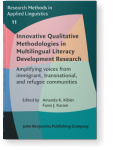Chapter 10
Embodied reflexivity and researching the literacy practices of an
adolescent multilingual refugee who is
d/Deaf/Hard-of-Hearing
In this chapter I extend recent scholarship on researcher
subjectivities in Applied Linguistics by considering affective,
spatial, and corporeal dimensions of reflexivity and positionality.
I draw from ethnographic research on the multisemiotic language and
literacy practices of Madou (a pseudonym), an adolescent refugee
student from the eastern region of the Democratic Republic of Congo
(DRC) who was diagnosed as having a severe hearing impairment upon
his arrival to the United States as a middle schooler. I conclude by
presenting implications for how considering positionality as
embodied can yield novel analyses and foster relational ethics in
research on the literacy development of multilingual learners from
immigrant, transnational, and refugee backgrounds, including those
who are d/Deaf and hard of hearing (DML).
Article outline
- Introduction
- Overview of the study and its findings
- Background and theoretical framings
- Research context and participants
- Research design
- Classroom observations
- Mediated and unmediated interviews
- Analysis of writing
- Example of findings: Madou the scribe
- Methodological discussion: Rethinking positionality for more equitable research
- Embodied reflexivity
- Positioning in the field: What is seen and not seen
- Writing as witnessing
- The research design and the role of intermediaries
- Implications for qualitative research on multilingual literacy
development
- Considerations for incorporating embodied reflexivity in research on multilingual literacy
-
Notes
-
References
This content is being prepared for publication; it may be subject to changes.
